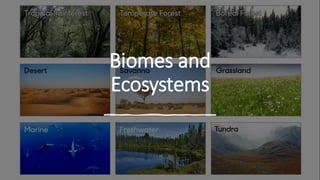
Biomes and Ecosystems Guide
- 2. What is a biome? • A regions of the world with a similar climate – the amount of rainfall and temperature. • A large community of vegetation and wildlife adapted to a specific climate
- 3. There are three main climate zones on Earth that help form our biomes •Tropical •Temperate •Polar.
- 4. An area’s biome is determined mostly by its climate 1. temperature 2. precipitation
- 5. Other factors that affects biomes: Latitude Elevation Ocean currents
- 6. How temperature influence biome? Precipitation is also influenced by temperature. Warm air can hold more moisture than cold air, so tropical areas receive more rainfall than other parts of the world. Nearness to the ocean and mountain ranges may also influence the amount of precipitation an area receives.
- 7. There are 6 major land biomes and 2 major water ecosystems? LAND (6): RAINFORESTS, DESERTS, GRASSLANDS, DECIDOUS FORESTS, BOREAL FORESTS, & TUNDRA WATER (2): FRESHWATER & MARINE ECOSYSTEMS
- 9. RAIN FORESTS There are 2 main types of rain forests: Temperate Rain Forests and Tropical Rain Forests.
- 10. TEMPERATE RAIN FORESTS • “Temperate”= having moderate temperatures. • Northwestern coast of U.S. is a temperate rain forest. • Receives more than 300 cm of rain per year. • Huge trees: Cedars, Redwoods, Douglas Firs.
- 11. TROPICAL RAIN FORESTS • Found in regions close to the equator • Warm and humid all year long. • Lots of precipitation. • Diverse plant growth.
- 12. Trees in the rain forest form several layers… Canopy: A leafy roof formed by the tallest trees. Understory: A second layer of shorter trees and vines.
- 13. Understory plants grow well in the shade formed by the canopy, but the forest floor is nearly dark and only a few plants live there.
- 14. DESERTS • Desert = An area that receives less than 25 cm of rain per year. • Some deserts receive NO precipitation at all during one year. • Deserts often undergo large shifts in temperature during the course of a day.
- 15. The scorching Namib desert in Africa cools rapidly after the sun goes down. The Gobi desert in central Asia is cooler and even experiences freezing temperatures in the winter.
- 16. Organisms that live in the desert must be adapted to the lack of rain and extreme temperatures. Saguaro Cactus: Stem expands to store water. Gila monster spends weeks in its cool, underground burrows. Many other organisms are only active at night when it is cooler.
- 17. GRASSLANDS • Grassland (prairie)= An area that is populated mostly by grasses and other non-woody plants. • Receive 25 to 75 cm of rain per year. • Fires and droughts are common.
- 19. • Grasslands are home to many of the largest animals on Earth. • Examples: Grazing by these large herbivores helps to maintain these grasslands.
- 20. DECIDUOUS FOREST • Deciduous trees= Trees that shed their leaves and grow new ones each year (Oaks, Maples…) • Receive enough rain to support the growth of trees and other plants (at least 50 cm per year). • Growing season is 5 to 6 months long.
- 21. BOREAL FOREST (taiga) • Mostly contains coniferous trees (trees that produce their seeds in cones and have leaves shaped like needles). Ex. Fir, Spruce, Hemlock… • Very cold winters (a lot of snow). • Warm and rainy summers.
- 22. TUNDRA PERMAFROST Tundra = Extremely cold and dry biome. Usually receives NO more precipitation than a desert biome. Most soil is frozen all year long (permafrost) During summer, the top layer of soil thaws, but the rest remains frozen.
- 24. Because rainwater cannot soak into the permafrost, there are many shallow ponds and marshy areas of the tundra during the summer
- 25. Tundra Plants and Animals ARCTIC HARE ARCTIC FOX REINDEER POLAR BEAR WOLF
- 26. FRESHWATER ECOSYSTEMS Freshwater ecosystems include streams, rivers, ponds and lakes.
- 27. Rivers and Streams • Animals adapt to the stream/river’s current (hooks and suckers to cling to rocks, streamline bodies). • Few -plants or algae can grow because of the strong currents. • Animals rely on seeds and leaves to fall in the water as food.
- 29. Ponds and Lakes • Bodies of standing or still freshwater. • Lakes are larger and deeper than ponds. • Ponds: Shallow enough for sunlight to hit bottom (allowing plants to grow there). • Lakes (and large ponds): Too deep for plants to grow on the bottom, so algae grows and floats on top of water.
- 31. MARINE ECOSYSTEMS Marine ecosystems include estuaries, intertidal zones, neritic zones, and the open ocean.
- 32. Estuary: Where freshwater of a river meets saltwater of the ocean.
- 33. Intertidal Zone: The area between the highest high tide line and the lowest low tide line. • Organisms here must be able to survive the pounding waves, water level changes, and temperature changes • Ex. (barnacles, starfish, snails, clams….)
- 34. Neritic Zone: The area below the low tide line which extends over the continental shelf. • Sunlight passes through this zone, so photosynthesis can occur (plants can grow). • Many living things. • Coral reefs may form in water is warm.
- 35. Open Ocean: Separated into two zones: • Surface Zone: The first few hundred meters deep of the ocean (where light penetrates). • Deep Zone: Below the surface zone (totally dark and home to many BIZZARE organisms).